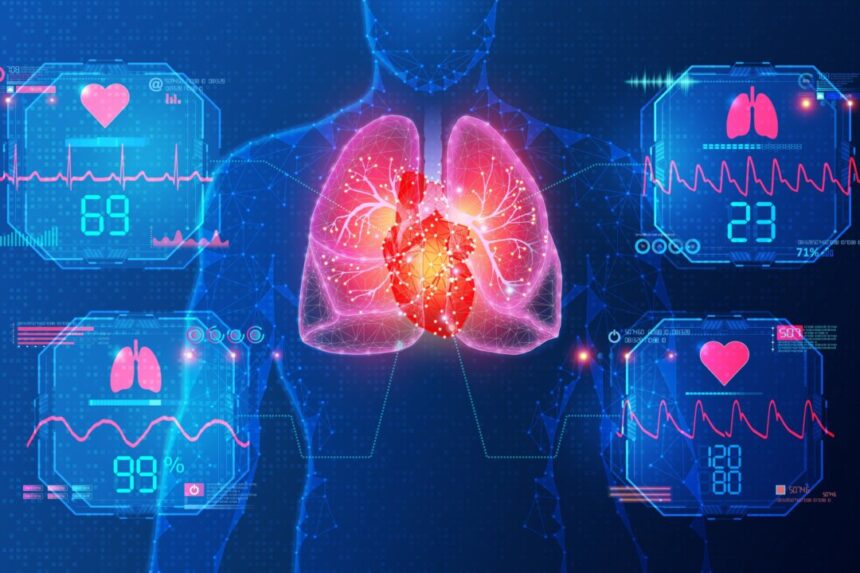Research shows that higher heart rate variability levels suggest a healthier and more flexible heart.
Many people know how to track their heart rate, but few track a lesser-known signal that might reveal even more about their health: heart rate variability, or HRV. Once associated with alternative health, HRV is gaining mainstream traction as a marker of physical and mental well-being, especially as chronic conditions rise globally.
“Heart rate variability is now recognized as valuable in interventions for depression, anxiety, PTSD, and more,” says neuropsychologist and HRV researcher J.P. Ginsberg in an interview with The Epoch Times. “It was once on the fringe, hardly recognized, but now it’s alive and well—applied in larger-scale research and clinical settings.”
With its potential to provide real-time insights into both physical and mental well-being, HRV might soon become a health tool for everyone.
What Is HRV?
Heart rate variability reflects the subtle changes in timing between each heartbeat. While heart rate indicates how fast the heart beats, HRV tracks the rhythm and variation between beats, much like noticing the pace of each step versus simply counting them. Similar to walking speed, some variability is considered healthy.
When you’re relaxed and well-rested, there’s more variation between beats—your heart isn’t locked into a strict rhythm. But during times of stress, anxiety, or exhaustion, the heart often beats more evenly, with less variation. Low HRV suggests that your body is working harder to cope, potentially signaling that recovery from stress is limited.
Marco Altini, scientist and founder of HRV4Training, explained in an email to The Epoch Times that when we face a challenge or perceived threat, the autonomic nervous system lowers parasympathetic activity, affecting heart rhythm. While stress itself isn’t directly measurable, HRV offers a reliable gauge of how the body responds to exercise, lifestyle choices, and everyday stress.
“HRV provides insight into how your body is responding to stress, how well you are recovering, and how resilient your system is,” said Altini. “Whether you’re managing stress at work, dealing with family responsibilities, or trying to stay fit, HRV can serve as a window into your body’s capacity to cope with life’s demands,” he said.
Why HRV Matters
HRV isn’t just a fitness metric—it’s an important indicator of physical and mental health. High HRV typically indicates a strong, adaptable cardiovascular system, while low HRV can be an early warning of potential health risks.
“When HRV is high, it’s a sign of resilience and better health status,” said Ginsberg. “Chronically low HRV, however, often means lower health status and higher vulnerability to various diseases.”
HRV has become a broad-spectrum indicator of longevity and adaptability, directly linked to the body’s capacity to stay resilient, he explained.
HRV also offers insights into emotional resilience, says Altini. Lower HRV is often linked to anxiety, depression, and cognitive decline, indicating how well your body handles daily stress. Consistently low HRV may suggest that chronic stress is impacting mood, focus, and overall mental resilience. In this way, HRV provides real-time insights into your body’s ability to stay balanced and resilient.
How Is HRV Measured?
HRV isn’t typically measured in a routine doctor’s visit, though some practitioners, including chiropractors and certain cardiologists, offer HRV testing. HRV measurement may also be included in cardiopulmonary stress tests, often performed on a treadmill or stationary bike.
Wearables like smartwatches and fitness trackers have made HRV monitoring more accessible. They use wrist-based optical sensors to estimate HRV through pulse rate variability (PRV).
“Wearables have become quite good at measuring HRV, provided there is no movement during the measurement,” says Altini, who recommends nighttime measurements for accuracy.
Ginsberg notes that wearables have popularized HRV tracking but lack clinical precision.
“Wearables are very useful for intra-individual tracking,” he explained, meaning they’re suitable for observing one’s HRV trends over time. However, they can miss beats or lose skin contact, which affects their accuracy for precise clinical or scientific use.
“Devices that measure HRV from sensors on the fingertip or earlobe can provide more consistent results,” said Ginsberg, as these placements are less prone to losing contact, offering a more reliable option for those seeking higher accuracy.
For those wanting ECG-level precision without a clinic visit, pairing an HRV app with a chest-strap monitor is an option. Chest-strap monitors are wearable devices that wrap around the chest to capture electrical signals directly from the heart, similar to an ECG. This approach provides a more reliable and clinically relevant way to track HRV trends at home.
What Is an Ideal HRV?
There’s no one-size-fits-all HRV target. Factors like age, fitness level, genetics, and lifestyle influence each person’s HRV. Rather than aiming for a universal number, the goal should be establishing a personal baseline—a range that reflects your unique state when feeling well, says Altini.
Shorter daily readings, like those between 30 and 50 milliseconds, can also reflect healthy patterns, though they capture immediate fluctuations rather than long-term averages. Rather than aiming for a specific number, people should focus on maintaining HRV within their own consistent baseline, as HRV naturally varies with age, lifestyle, and fitness level.
Maintaining your baseline is important. What matters most is consistency, says Altini.
“An ideal response means your HRV stays stable over time, within your normal range,” he explains.
Significant drops or steady declines can signal that the body may need more rest, better stress management, or other lifestyle adjustments. Daily HRV can fluctuate due to stress, sleep, diet, and more, but tracking regularly helps distinguish between normal variability and meaningful changes.
“I wouldn’t say everyone needs to measure HRV, but it can be a valuable tool for many people, not just athletes,” said Altini.
He suggests starting with a morning measurement while sitting. Some apps, such as the one created by Altini, determine your baseline and detect deviations that may signal increased stress or recovery needs.
For most, the goal isn’t to achieve a higher HRV but to maintain a steady range that reflects their unique health and resilience. Monitoring HRV offers real-time feedback on how lifestyle changes, like better sleep, balanced nutrition, and regular exercise, impact well-being. By focusing on these trends, anyone can use HRV data to enhance their physical and mental resilience.
What Improves HRV?
The autonomic nervous system largely functions without our conscious input, managing involuntary processes like heartbeat, digestion, and stress response. However, one powerful way we can influence it is through our breath. Ginsberg explains that while we can’t control the ANS directly, intentional breathing patterns allow us to regulate HRV, making breathwork one of the most effective ways to improve it.
“Breath control is strictly voluntary,” says Ginsberg. “As you breathe, your autonomic system responds. Deep, slow breathing promotes parasympathetic activity, helping the body enter a relaxed state.”
Practicing slow, deep breathing can increase HRV, thus signaling greater resilience to stress and more robust autonomic functioning.
For optimal HRV, Ginsberg recommends resonance frequency breathing—about six breaths per minute or one 10-second breath cycle (in and out). People can adjust slightly to find a rhythm that feels natural.
- Regular physical activity—Regular, moderate exercise has been shown to improve HRV over time, with aerobic activities like walking, running, and cycling being especially effective. “Exercise remains one of the main tools at our disposal to improve our health (and HRV!),” wrote Altini. Balance is key, though—overtraining can reduce HRV, signaling the body’s need for recovery.
- Quality sleep—Sleep is a powerful driver of HRV. Consistent, high-quality sleep helps the body recover, while poor sleep can lower HRV, says Altini. Maintaining a regular bedtime, minimizing screen time before bed, and creating a restful environment all support better sleep—and a higher HRV, also improving heart rate and blood pressure
Stress Management Techniques
- Mindfulness—Practices like mindfulness, meditation, and yoga can positively impact HRV by reducing stress. Ginsberg explains that these “bottom-up therapies” help manage the body’s physiological responses, working from the body to calm the mind—different from “top-down” approaches, like cognitive therapies.
- Balanced diet—A balanced diet also plays a role in improving HRV. Whole foods that regulate blood sugar levels and support cardiovascular health are especially helpful. “Eating a balanced diet that supports metabolic health can help maintain a more resilient autonomic system,” said Altini.
- Hydration and reduced stimulants—Staying hydrated is essential for optimal heart function, while reducing stimulants like caffeine—especially in the afternoon—can improve sleep and help stabilize HRV.
Together, these lifestyle and targeted breathwork practices offer accessible ways to improve HRV, boosting resilience to stress and supporting long-term health.
“HRV is within our control with our breath,” says Ginsberg.
By making small, mindful adjustments, people can use HRV as an ongoing tool to enhance overall well-being.
Boosting Health With HRV Biofeedback
One of the most empowering uses of HRV is biofeedback training, which uses real-time HRV monitoring to help people manage stress and build resilience. Unlike traditional treatments that rely on ongoing medication or therapy, HRV biofeedback is a self-directed tool easily integrated into daily routines for lasting benefits.
HRV biofeedback allows people to use real-time HRV monitoring to fine-tune their breathing and activate the parasympathetic system, which promotes rest and recovery. Ginsberg notes that this technique is especially valuable for people dealing with chronic stress, anxiety, PTSD, and high blood pressure, helping reduce stress responses and enhance overall well-being.
“The beauty of HRV biofeedback is that it’s self-empowering,” says Ginsberg. “By learning to regulate your breathing, you gain a way to manage stress, improve mental resilience, and, in many cases, even help alleviate symptoms of chronic conditions. It’s a skill anyone can develop, benefiting mental and physical health alike.”






